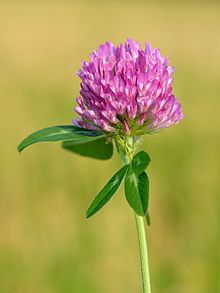Red clover
| Trifolium pratense | |
|---|---|
 |
|
| Scientific classification | |
| Kingdom: | Plantae |
| (unranked): | Angiosperms |
| (unranked): | Eudicots |
| (unranked): | Rosids |
| Order: | Fabales |
| Family: | Fabaceae |
| Subfamily: | Faboideae |
| Genus: | Trifolium |
| Species: | T. pratense |
| Binomial name | |
|
Trifolium pratense L. |
|
Trifolium pratense, the red clover, is a herbaceous species of flowering plant in the bean family Fabaceae, native to Europe, Western Asia and northwest Africa, but planted and naturalised in many other regions.
It is a herbaceous, short-lived perennial plant, variable in size, growing to 20–80 cm tall. The leaves are alternate, trifoliate (with three leaflets), each leaflet 15–30 mm long and 8–15 mm broad, green with a characteristic pale crescent in the outer half of the leaf; the petiole is 1–4 cm long, with two basal stipules that are abruptly narrowed to a bristle-like point. The flowers are dark pink with a paler base, 12–15 mm long, produced in a dense inflorescence, and are mostly visited by bumblebees.
The red clover is found natively in Europe, Western Asia, and northwest Africa, but it has been naturalized in other continents, like North and South America. Specifically, the red clover was brought to Argentina and Chile over 100 years ago, although it is not clear how exactly it was introduced. The red clover has become increasingly important as a source of economic stability in Chile, which has made the need for pollinators even more important. One important pollinator, which was also brought from Europe, is Bombus ruderatus, or the large garden bumblebee. This bumblebee has been one of the important pollinators of red clover in South America and other countries like New Zealand.
It is widely grown as a fodder crop, valued for its nitrogen fixation, which increases soil fertility. For these reasons, it is used as a green manure crop. Several cultivar groups have been selected for agricultural use, mostly derived from T. pratense var. sativum. It has become naturalised in many temperate areas, including the Americas and Australasia as an escape from cultivation.
...
Wikipedia
